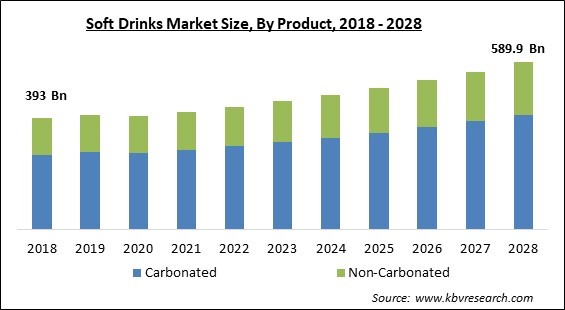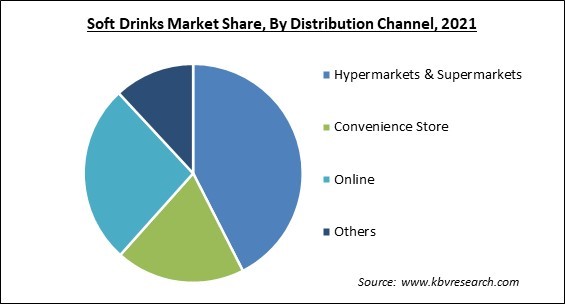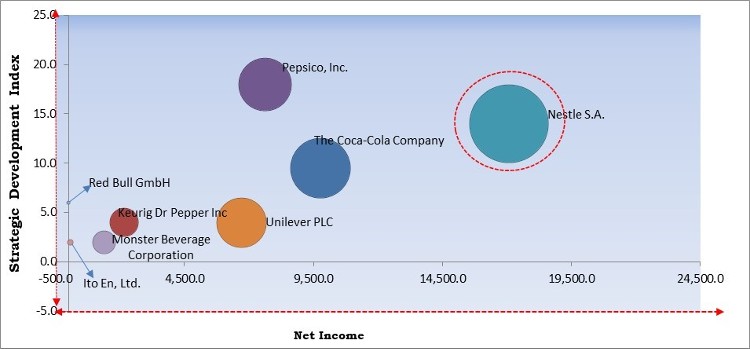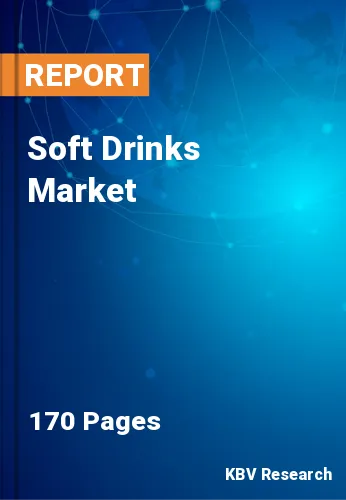The Global Soft Drinks Market size is expected to reach $589.9 billion by 2028, rising at a market growth of 5.3% CAGR during the forecast period.
A soft drink is a nonalcoholic beverage that is usually but not always carbonated and contains a natural or artificial sweetener, edible acids, artificial or natural flavors, and often juice. Fruits, berries, nuts, herbs, roots, and other plant sources are used to create natural flavors. Soft drinks exclude coffee, tea, milk, chocolate, and undiluted vegetable & fruit juices. To differentiate flavored drinks from hard alcohol, or distilled spirits, the term soft drink was coined. Soft drinks were advised as an alternative in an effort to improve early Americans' hard-drinking behavior. Indeed, modern consumers' health concerns prompted the creation of new soft drink categories stressing low calorie, low salt, caffeine-free, and "all-natural" components.
Carbon dioxide gas adds sparkle and tanginess to the beverage while also preventing spoiling. It is delivered to the soft drink producer in either solid (dry ice) or liquid form in massive steel containers under the pressure of around 1,200 pounds per square inch (84 kilograms per square cm). When liquid carbon dioxide is kept refrigerated, lightweight steel containers are employed. The internal pressure in that situation is around 325 pounds per square inch. Cooling the liquid and cascading it in small layers above a set of plates in an enclosure carrying carbon dioxide gas under pressure causes carbonation of either the water or the completed beverage mixture.
As the pressure and temperature are increased, the amount of gas that the water would absorb increases. Flavoring syrup is a condensed mixture of a sweetener (sugar or artificial), an acidulant for tartness, flavoring, and, if necessary, a preservative. If the sugar quality is low, such a simple sugar solution could be treated with charcoal and filtered. The remaining ingredients are then combined in an accurate order to create a finished syrup.
Syrups are blended and mixed with plain or carbonated water, containers are washed, and containers are filled almost completely by automatic machinery. Reusable bottles are washed for at least five minutes in hot alkali solutions before being rinsed completely. Before filling, single-service or "one-trip" containers are usually air-rinsed or washed with potable water. Several containers can be filled every minute with automatic fillers.

The outbreak of COVID-19 pandemic have significantly impede the soft drinks market. This is due to complete halt on manufacturing outlets where the soft drinks are produced. As well as the distribution and logistics channel are being hampered by this pandemic. All across the world, a number of festivals, sporting events, exhibitions, and other public gatherings have been canceled. As a result, the entire production and supply chain was disrupted. The market had a sales shortfall as a result of disrupted supply chains and lower demand. In several region, non-alcoholic beverages business, the two cola behemoths today hold a joint market share of significance. The companies either own the production activities or outsource it to third-party bottlers in various parts of the country.
The Ready-to-drink (RTD) soft drinks have grown in popularity as a result of customers' changing lifestyles. The food and beverage industry's low-calorie RTD carbonated soft drink market is being upgraded as the need for gluten-free, low-calorie, clean-label, and low-carb products grow. The low-calorie RTD carbonated soft drink industry has grown in response to the growing market for functional beverages and rising consumer health problems. Minimal-calorie RTD beverages with low carbs, reduced artificial sweeteners, and sugar are also available from the company.
The fast-food business is one of the major contributors to the growth of the carbonated soft drink market in several regions. McDonald's, Domino's, Pizza Hut, Subway, Burger King, and a slew of other fast food businesses are offering minimum price great value meals. The majority of such meals are served with a beverage, which is usually a soft drink. The reason behind fast food joints serving soft drinks is the prolonged habit of consumers to digest as well as enjoy the food more. It is observed that consuming fast food alone leads to a temporary choke in the food pipe, and when the same fast food is served with a suitable beverage i.e., a soft drink then its taste gets enhanced.
The excessive use of soda and sugar in numerous regions within the population are enacting more restrictive rules and regulations, which are limiting the intake of soft drinks. To reduce the usage of carbonated soft drinks, many regional governments have introduced soda and sugar tariffs in order to keep on components included in soft drinks. The soft drinks companies are being hampered by such stringent rules and regulations. Rising public health concerns about the effects of soda use and sugar content, such as diabetes and obesity, are making existing and potential consumers hesitant of consuming the soft drinks.

Based on Distribution Channel, the market is segmented into Hypermarkets & Supermarkets, Convenience Store, Online, and Others. The online segment garnered a significant revenue share in the soft drinks market in 2021. This is because of its simplicity and convenience offered by online channels, people are increasingly turning to online shopping portals and mobile apps for purchasing. Online platforms offer products at lower prices than offline channels. People feel more comfortable while shopping any kind of product on online portal, in current scenario healthy soft drinks as people do not develop the fear of being judged while searching and asking about the product. Also, it is observed that people tend to look and shop more products especially new health centric eatables when shopping medium is online shopping.
Based on Product, the market is segmented into Carbonated and Non-Carbonated. The carbonated segment acquired the highest revenue share in the soft drinks market in 2021. Carbonated beverages are more popular, resulting in increased market growth. To ensure that it has something for everyone, the items are constantly enhanced and reinvented. Flavors, sugar, coloring agents, and sweeteners are among the substances that give the drink its flavor and keep it chilled. Additionally, advances in manufacturing technology, such as mass production lines and enhanced packaging methods, are boosting market revenue.
| Report Attribute | Details |
|---|---|
| Market size value in 2021 | USD 414.5 Billion |
| Market size forecast in 2028 | USD 589.9 Billion |
| Base Year | 2021 |
| Historical Period | 2018 to 2020 |
| Forecast Period | 2022 to 2028 |
| Revenue Growth Rate | CAGR of 5.3% from 2022 to 2028 |
| Number of Pages | 170 |
| Number of Tables | 264 |
| Report coverage | Market Trends, Revenue Estimation and Forecast, Segmentation Analysis, Regional and Country Breakdown, Competitive Landscape, Companies Strategic Developments, Company Profiling |
| Segments covered | Product, Distribution Channel, Region |
| Country scope | US, Canada, Mexico, Germany, UK, France, Russia, Spain, Italy, China, Japan, India, South Korea, Singapore, Malaysia, Brazil, Argentina, UAE, Saudi Arabia, South Africa, Nigeria |
| Growth Drivers |
|
| Restraints |
|
Based on Regions, the market is segmented into North America, Europe, Asia Pacific, and Latin America, Middle East & Africa. North America emerged as the leading region in the soft drinks market with the largest revenue share in 2021. Early acceptance and well-developed economies, such as the United States and Canada, are boosting market growth. The increased production of soft drinks, as well as expenditures in developing packaging technology and manufacturing assembly lines, are supporting the growing demand for soft drinks. The existence of widely recognized brands in this region, such as Coca-Cola and PepsiCo, will increase industry demand.
Free Valuable Insights: Global Soft Drinks Market size to reach USD 589.9 Billion by 2028

The major strategies followed by the market participants are Product Launches. Based on the Analysis presented in the Cardinal matrix; Nestle S.A. is the forerunner in the Soft Drinks Market. Companies such as The Coca-Cola Company, PepsiCo, Inc. and Unilever PLC are some of the key innovators in the Market.
The market research report covers the analysis of key stake holders of the market. Key companies profiled in the report include PepsiCo, Inc., Nestle S.A., The Coca Cola Company, Keurig Dr Pepper, Inc., Monster Beverage Corporation, Ito En, Ltd., Unilever PLC, Red Bull GmbH, AriZona Beverage Company LLC, and Appalachian Brewing Company.
By Distribution Channel
By Product
By Geography
The global soft drinks market size is expected to reach $589.9 billion by 2028.
Growing popularity for zero-calorie carbonated drinks are driving the market in coming years, however, government restrictions and growing health issues growth of the market.
PepsiCo, Inc., Nestle S.A., The Coca Cola Company, Keurig Dr Pepper, Inc., Monster Beverage Corporation, Ito En, Ltd., Unilever PLC, Red Bull GmbH, AriZona Beverage Company LLC, and Appalachian Brewing Company.
The Hypermarkets & Supermarkets segment acquired maximum revenue share in the Global Soft Drinks Market by Distribution Channel in 2021, thereby, achieving a market value of $233.3 billion by 2028.
The Non-Carbonated segment is showcasing CAGR of 4.7% during (2022 - 2028).
The North America market dominated the Global Soft Drinks Market by Region in 2021, and would continue to be a dominant market till 2028.
Our team of dedicated experts can provide you with attractive expansion opportunities for your business.

